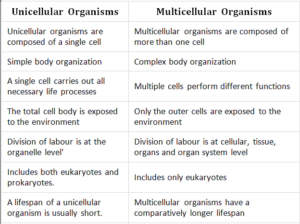Unicellular Organisms and Multicellular Organisms


The basic difference between Unicellular Organisms and Multicellular Organisms is that Unicellular organisms are those that are made up of a single cell, for example, bacteria and yeasts; multicellular organisms are those that are made up of two or more cells, for example, the shark, the vulture, the eucalyptus.
What are unicellular organisms?
Unicellular organisms are microscopic organisms that gather all their vital functions in a single cell. Almost all prokaryotic organisms (having cells without a cell nucleus) and some eukaryotic organisms (having cells with a cell nucleus) are unicellular.
Within the Monera kingdom, all bacteria are unicellular organisms, for example escherichia coli, salmonella typhi, and all archaea, for example, the methanogenic archaea. Within the fungi kingdom, yeasts, for example Pichia, saccharomyces cerevisiae (brewer’s yeast ); within the kingdom Protista, the protozoa, for example, the paramecium and the dinoflagellates.
Characteristics of unicellular organisms
- They are present in all ecosystems.
- The number of them far exceeds multicellular organisms.
- They are considered more primitive than multicellular organisms.
- They reproduce asexually.
- There are heterotrophic and autotrophic unicellular organisms.
- They can group together forming colonies.
Examples of unicellular organisms
| Amoeba | Cyanidiophytina | Yeast |
| archaea | diatom | microalgae |
| Bacterium | Dinoflagellates | paramecium |
| Chlorella | Euglena | protozoa |
- Read Also: Unicellular organisms
What are multicellular organisms?
Multicellular organisms are made up of two or more cells that specialize in different vital functions (neurons, epithelial cells, red blood cells). These specialized cells form tissues that in turn make up the organs of the living being.
All animals and plants are multicellular organisms, for example, mammals like the lion, amphibians like the frog, trees like the oak, and herbaceous plants like the onion. Some fungi and some organisms of the Protista kingdom are also multicellular, for example, mushrooms, and algae.
Characteristics of multicellular organisms
- They are also called multicellular.
- They are eukaryotic organisms.
- They are made up of specialized cells that can be very different from each other.
- The cells that make them up are related to each other and need each other.
- They are microscopic organisms more complex and developed than unicellular organisms.
- They initially arise from a single cell that multiplies through mitosis or meiosis.
Examples of multicellular organisms
| Avocado | kelp | Dog |
| Brown algae | Lettuce | Porphyra |
| Horse | Daisy flower | portobello |
| Chicken | Mosquito | Oak |
| Sparrow | nematodes | Chinese mushroom |
| Hydrangea | Palmaria palmata | black truffle |
Related Post
Recent Posts
Difference between Gastritis and ulcer
Gastritis and ulcers are irritations, which must be treated urgently in order not to develop…
Saudi Arabia launches new residency plans to draw foreign talent
On Thursday, Saudi Arabia unveiled fresh residency programs geared towards drawing in skilled professionals and…
Study in UAE: Your Complete Guide to Enrolling Abroad
Studying abroad can be a life-changing experience, opening doors to new cultures, perspectives, and opportunities.…
Difference between Osmosis and dialysis
The difference between osmosis and dialysis is that Osmosis is a physical phenomenon by…
Difference between Vitamins and proteins
The Difference between Vitamins and Proteins is given here. Vitamins and proteins are essential…
Difference between Windows and Linux
The Difference between Windows and Linux is given here. Windows and Linux are operating systems…